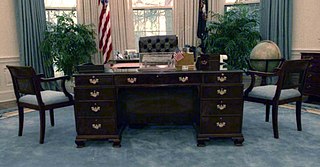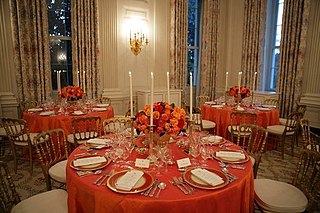 W
WThe C&O desk is one of only six desks ever used in the Oval Office by a sitting President of the United States. The C&O Desk was used there only by George H. W. Bush, one of two Oval Office desks to be used by only one president. Prior to its use in the Oval Office by Bush, the desk had been used elsewhere in the White House. It is the shortest-served Oval Office desk to date, having been used for only one four-year term.
 W
WThe china service of the Lincoln administration generally refers to a set of purple-banded china (porcelain) dishes used for serving and eating food at the White House, home of the president of the United States for state dinners. Also known as the Lincoln solferino china service, it was purchased in April 1861 by First Lady Mary Todd Lincoln. The porcelain was manufactured by Haviland & Co. in France, and some of the decoration of the china was made overseas. Additional decoration was made by the American firm of E. V. Haughwout & Co., which sold the china to Mrs. Lincoln.
 W
WThe Hoover desk is a large block front desk, designed by J. Stuart Clingman and built by the Robert W. Irwin Company, used by Presidents Herbert Hoover and Franklin D. Roosevelt in the Oval Office as their Oval Office desk. Created in 1930 as a part of a 17-piece office suite by furniture makers from Grand Rapids, Michigan, it was given to the White House by the Grand Rapids Furniture Manufacturers Association. The Hoover desk is one of only six desks to be used by a President in the Oval Office.
 W
WThe Johnson desk is a mahogany partners desk that was used by U.S. President Lyndon B. Johnson in the Oval Office as his Oval Office desk. One of only six desks used by a president in the Oval Office, it was designed by Thomas D. Wadelton and built in 1909 by S. Karpen and Bros. in Chicago. The desk was built as part of 125 seven-piece office sets for senators' offices in the Russell Senate Office Building, and was used by Johnson during his terms as U.S. Senator, Vice President, and President. It is currently located at Lyndon Baines Johnson Library and Museum as part of a replica Oval Office.
 W
WSince the construction of the Oval Office in 1909, there have been six different desks used in the office by the president of the United States. The desk usually sits in front of the south wall of the Oval Office, which is composed of three large windows, has an executive chair behind, and has chairs for advisors placed to either side or in front. Each president uses the Oval Office, and the desk in it, differently. It is widely used ceremonially for photo opportunities and press announcements. Some presidents, such as Dwight D. Eisenhower, used the desk in this room only for these ceremonial purposes, while others, including Richard Nixon used it as their main workspace.
 W
WSome presidents of the United States have had a red call button in the Oval Office of the White House that could call aides. This button was noted as being on the Resolute desk since at least the George W. Bush presidency and sits in an approximately 9 in (23 cm) long by 3 in (7.6 cm) wide wooden box marked with a golden presidential seal. The button is frequently found on the Resolute desk.
 W
WThe Resolute desk, also known as the Hayes desk, is a nineteenth-century partners desk used by several presidents of the United States in the White House as the Oval Office desk, including the five most recent presidents. The desk was a gift from Queen Victoria to President Rutherford B. Hayes in 1880 and was built from the oak timbers of the British Arctic exploration ship HMS Resolute. The 1,300-pound (590-kilogram) desk was created by William Evenden, a skilled joiner at Chatham Dockyard in Kent, probably from a design by Morant, Boyd, & Blanford.
 W
WThe desk in the Vice President's Ceremonial Office in the Eisenhower Executive Office Building, colloquially known as the Theodore Roosevelt desk, is a large mahogany pedestal desk in the collection of the White House. It is the first of six desks that have been used by U.S. presidents in the Oval Office, and since 1961 has been the used as the desk of the U.S. Vice President.
 W
WThe White House china refers to the various patterns of china (porcelain) used for serving and eating food in the White House, home of the president of the United States. Different china services have been ordered and used by different presidential administrations. The White House collection of china is housed in the White House China Room. Not every administration created its own service, but portions of all china services created for the White House are now in the China Room collection. Some of the older china services are used for small private dinners in the President's Dining Room on the Second Floor.
 W
WThe White House Christmas Tree, also known as the Blue Room Christmas Tree, is the official indoor Christmas tree at the residence of the president of the United States, the White House. The first indoor Christmas tree was installed in the White House sometime in the 19th century and since 1961 the tree has had a themed motif at the discretion of the First Lady of the United States.
 W
WThe desk in the Vice President's Room of the United States Capitol, colloquially known as the Wilson desk and previously called the McKinley-Barkley desk, is a large mahogany partner's desk used by Presidents Richard Nixon and Gerald Ford in the Oval Office as their Oval Office desk. One of only six desks used by a President in the Oval Office, it was purchased in 1898 by Garret Augustus Hobart, the 24th Vice President of the United States, for the Vice President's Room in the United States Capitol.